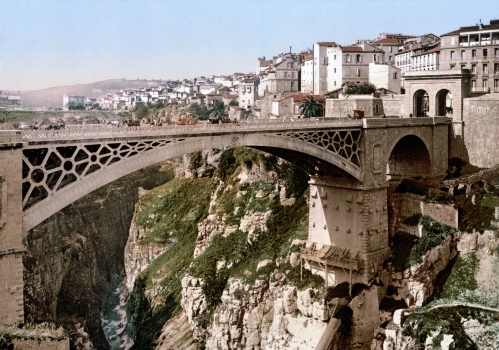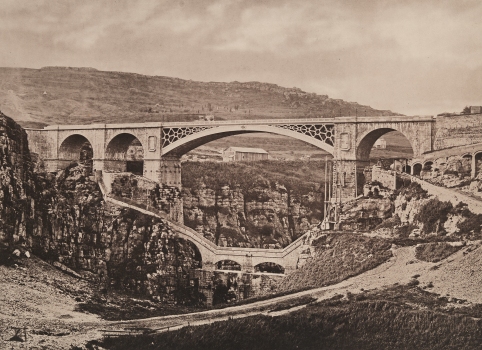General Information
Project Type
| Structure: |
Deck arch bridge |
|---|---|
| Function / usage: |
Road bridge |
| Material: |
Iron bridge |
Location
| Location: |
Constantine, Constantine, Algeria |
|---|---|
| Crosses: |
|
| Replaced by: |
Pont d'El Kantara (1952)
|
| Coordinates: | 36° 22' 8.34" N 6° 37' 5.50" E |
Technical Information
Dimensions
| main span | 57.40 m | |
| length | 128 m | |
| number of spans | 4 | |
| height above valley floor or water | 125 m |
Materials
| arches |
cast iron
|
|---|
Excerpt from Wikipedia
Bab El Kantra Bridge one of 8 famous high-level bridges that cross the Rhumel River gorge in Constantine, Algeria, the Kantara bridge is the oldest and has taken several different forms over the years from a 1792 Ottoman style multi-arch bridge to an 1863 French iron arch to its current form as a concrete arch bridge. Like the higher Sidi M'Cid Bridge, there is a unique, natural “bridge” almost directly under the span that blocks much of the river from view. Partial remains of the earlier stone bridges can still be seen on top of this natural bridge.
History
The El Kantara Bridge (Ar:القنطرة ,the Bridge in Arabic) was Constantine's main access route. It is the site of the main assaults on the city. In 1185 all the Roman bridges were destroyed. Only El Kantara is rehabilitated. In 1304 it was destroyed again.
- Between 1771 and 1792 Salah Bey, one of the most famous rulers of the city, promoted a good number of urbanization works and mosques. He entrusted the reconstruction of the Roman bridge to the Balearic builder Bartolomeo. To carry it out, he started from the foundations and ruins of the ancient bridge, and completed it with stone from the ruins of the ancient Roman amphitheater. The bridge roughly reproduces the configuration of the Roman original. The new reconstruction reduces the number of arches, solidifies the arches of the intermediate level and also re-establishes the siphon that supplies the city from Djebel Ouahch.
The Ottoman reconstruction is reflected in the testimony of Charboneau, of 1853: «The construction, as we see it today, was erected in 1788 and 1789 under the principality of Salah Bey by a Balearic engineer. It has two levels. The lower level is made up of two arches; one of them, close to the city, was solidified at an unknown time. The two arches are supported by three piers whose structure is obviously Roman, from the base to the cornice. On the second level, which rises 16 meters above the lower floor, it is made up of four arches. The two central ones lean on the lower arches; ist vaults are pointed, while the sides are circular vaults and visibly larger. The height of the bridge reaches 65 meters; the board is 60 meters long ».
Thus, the similarities between the description and the documentary images of the mid-19th century are evidenced: those taken in 1856 by John Beasley Greene, a photographer and archaeologist known for his travels to Egypt and the East.
in 1952 the actual bridge was inaugurated ended at a monumental gate with two stone arches that defended the entrance to the city. The two arches of this gate were very narrow and considerably hampered traffic.
Text imported from Wikipedia article "Bab El Kantra Bridge" and modified on February 21, 2022 according to the CC-BY-SA 4.0 International license.
Participants
Relevant Web Sites
Relevant Publications
- (2018): The El-Kantara Bridge in Algeria: An Early Development of Cantilevering Construction and What we can Learn from its Documentation in Text and Image (1862-63). In: Construction History, v. 33, n. 1 ( 2018), pp. 69-82.
- (1865): Pont d'El-Kantara à Constantine (Algérie). Notes, descriptions et dessins relatifs à la construction de l'échafaudage et de l'arche métallique. Thunot, Paris (France), pp. 32.
- (2015): Reconstrucciones históricas del puente de El Kantara en Constantine, Argelia. In: Informes de la Construcción, v. 67, n. 540 (October 2015), pp. e120.
- About this
data sheet - Structure-ID
20009824 - Published on:
05/08/2003 - Last updated on:
30/07/2019







